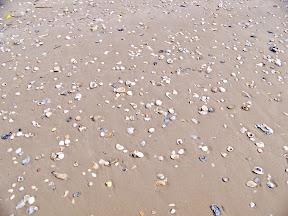Flatfish Fiesta
Andrea has got the magic touch. She caught four flounder this weekend, and let another three get away! Three of the ones she caught were keepers, too. I can't seem to catch one, even fishing in the same spots with the same lure. I guess my job is to take them off the hook, fillet them, and cook them. I think I got the stinky end of the stick, if you catch my meaning.
We rarely catch anything but catfish, black drum, and the occasional small redfish from the pier. This weekend the flounder were stacked up, and busting on all of the bait that was in the water. There were thousands of small shad in thick schools, all around the pier. Occasionally we would see a flounder spring up from the sandy bottom and send the bait jumping out of the way.
I examined the stomachs of each of the flounder I cleaned, and they were all filled completely with shad. Except for the largest one, which contained a decent sized shrimp. I found this interesting that it contained a shrimp - I guess it means that the shrimp have returned to our bay, too. This is great news, because it means that the red fish will be up in the grass soon, where they are easy to see.
I also caught a large gafftopsail catfish. It weighed about five pounds and put up a heck of a fight. I know people eat gafftops, but I just don't care to mess with all of the slimy goo they excrete. You always know you have a catfish on the line, because you can see the gunk on your line before you get the fish to the water's surface. I let this one go.
My boat was in the shop this weekend, getting some electronics installed. We took the opportunity to go exploring by truck. We drove out to Matagorda beach to see what was going on. On the way, we heard on the radio that it was adopt-a-beach clean-up day, so I anticipated that it would be busy when we got there.
We had to buy a beach access permit in Matagorda before we crossed the draw-bridge to get out on the island. The beach was quite literally crawling with people. The winter storms sure messed things up since the last time we visited. There were fallen trees and drift-wood all over the beach. People were busy cleaning things up.
We spent some time looking for shells, and letting our dog Heidi get some exercise. Heidi kept looking over the top of the dunes, so eventually I went up to see what she was looking at. I was amazed to find that behind the dunes was an extensive network of bayous and ponds.
We drove up a small road between the dunes to find many people with kayaks and fishing poles. I took the opportunity to go wade fishing, and so did Heidi, much to the dismay of my wife. The water was clear and cool. I was not wearing my wading gear, so I took it easy. Wearing only sneakers, I did not want to risk stepping on a sting-ray. We spooked quite a few redfish that were hiding in the grass, but I did not get any hook-ups. I think I will come back here eventually without the dog -- maybe I will have better luck.
The weather was perfect this weekend. The wind was out of the east on Friday, but shifted out of the south-east on Friday night. The water was a little murky, but much cleaner than it has been lately. I am excited that we caught flounder. Next weekend I think I will take the boat out in search of flounder. With my new trolling motor installed, I should be able to get right up next to the grass line.









